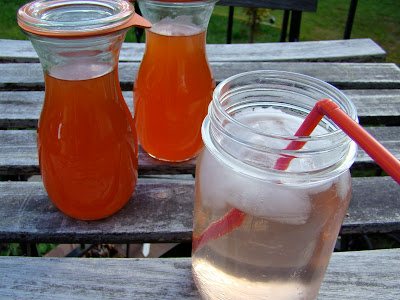This week Ethan and I are weeding and adding compost to our garden spaces, planning the garden, and enjoying the sunny, cool evenings. In the last two weeks our rhubarb plants have gone from barely poking out of the ground to being nearly two feet in diameter. Spring, she is here.
Before I go on, I have a confession: I am not the greatest rhubarb lover the world has seen. I prefer rhubarb mixed with other flavors. My dad will cut a stalk of rhubarb from the plant and take bites. Raw. Without sugar. I’m did not inherit that gene. I have come to appreciate rhubarb more as an adult, but I still like rhubarb mixed with another fruit or vegetables. Strawberry-rhubarb anything? Yes, please. Rhubarb chutney? Indeed. Rhubarb Jelly Barbeque sauce? Sounds great.
I canned a lot of fruit syrups last year. I’ve become a fan of making drinks at home with club soda and homemade fruit syrups. I don’t drink a lot of soda, but I do enjoy one occasionally (especially in the summer). Flavoring my own made sense. No artificial anything or extra preservatives, just fruit, sugar, and carbonated water. (We have a soda maker now; I highly recommend one if you’re inclined to purchase club soda often. There is less waste and you can make the soda water as you need it. We love ours).
Rhubarb with citrus and vanilla was one of the syrups I canned last summer and am still using now. (I like to can syrups in Weck juice jars. They are easier to pour from and they’re pretty—I’m a sucker for pretty jars).
Making your own flavored syrups doesn’t require much effort, makes for a MUCH healthier drink, and opens up a world of creative flavors that are unmatched by processed canned sodas. Rhubarb syrup is delicious. Put this recipe on your rhubarb list when it’s ready for harvest.
I based my recipe on several I researched, sticking to a simple ratio of rhubarb to sugar and adding my own supplementary flavors.
 |
| Rhubarb Syrup and a soda. Delicious. |
Rhubarb Syrup with Citrus and Vanilla
makes approximately 4 cups
1 ½ pounds rhubarb, chopped
3 cups water
zest of 1 lemon
zest and juice of 1 orange
½ vanilla bean, scraped
2 ½ cups sugar
This recipe can easily be made and stored in the refrigerator for immediate use, but is also safe for canning, which is what I did. Refrigerator space is precious around here.
Combine the rhubarb, water, lemon zest, orange zest, and vanilla bean in a non-reactive pot and bring to a boil.
Reduce heat and allow to simmer for about 10-15 minutes, or until the rhubarb is soft and has given most of its color.
Place a fine-mesh sieve over a bowl and strain the rhubarb juice—this should take about 30 minutes. Pressing the rhubarb in the sieve will make for cloudy syrup, so just let gravity to the job for you and take a break or get your canning pot ready while the juice drips through the sieve.
To can, fill your canning pot with your jars and cold water and bring to a boil. When the pot has reached a boil, turn the temperature down and simmer for 10 minutes or until you’re ready to fill the jars. Place the lids in a small saucepan and bring to a low simmer to soften the seal.
When the juice has strained, compost or discard the rhubarb solids and zest and place the juice back in the pot along with the juice of the orange (strained to remove pulp) and the sugar. Bring to a boil and simmer for 10-15 minutes until the syrup has thickened slightly.
Remove the jars from the canning pot. Fill with the syrup, leaving a full ½” headspace. Wipe rims, apply lids, and screw on bands. Process in a boiling water canner for 10 minutes (15 minutes for Spokane due to elevation).
When the time is up, pull the canning pot off of the heat and let sit for 5 minutes, then remove the jars and allow them to cool on a towel-lined countertop. Check the seals and store in a cool, dark place.
To make soda:
Add approximately 2 tablespoons syrup to a glass of ice, top with club soda, stir, and drink. It really is surprising and refreshing. I’ve also combined the rhubarb with strawberry syrup or Satsuma syrup. The combinations are great. I don’t ever use much more than 2 tablespoons of syrup, but it is easy to adjust for taste.

























